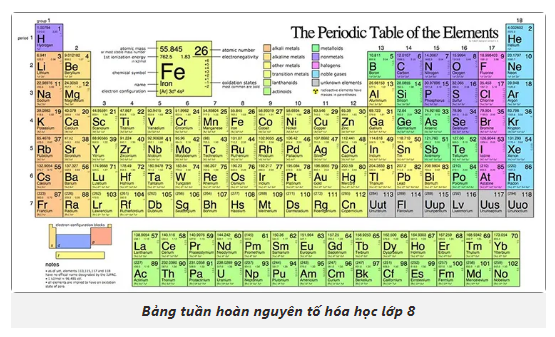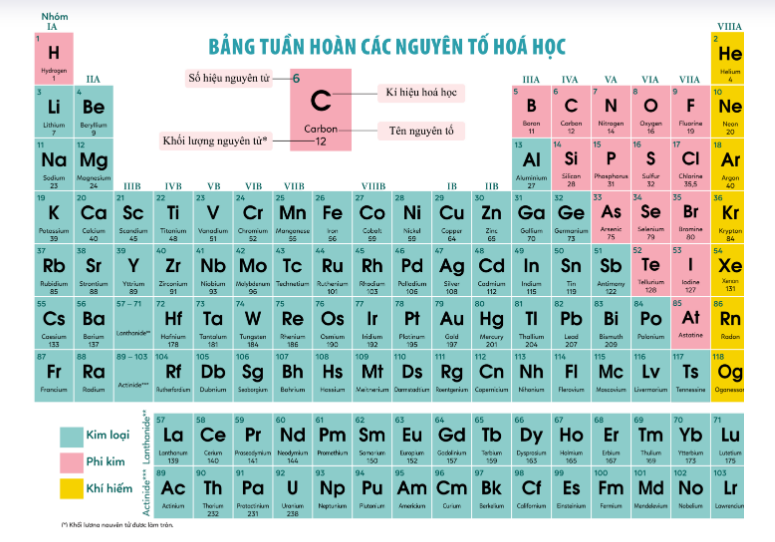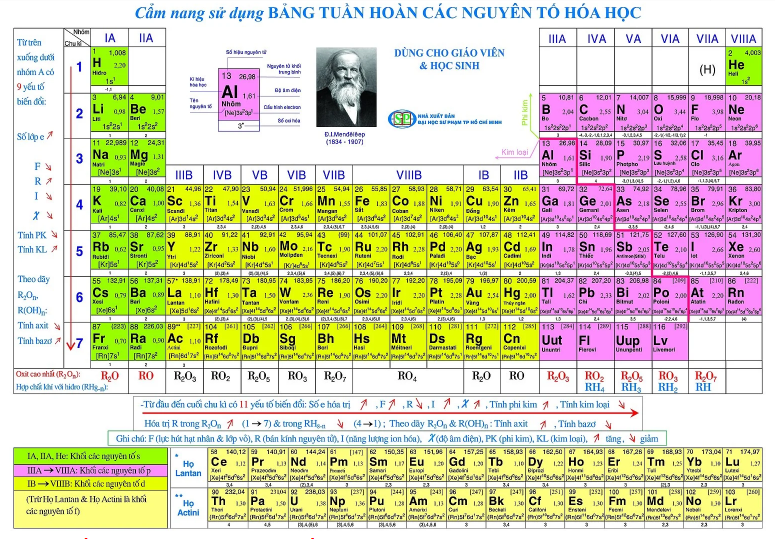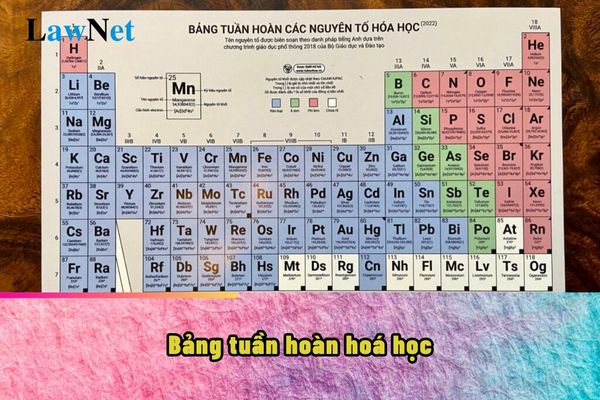Vietnam: Periodic Table for Grades 8, 9, and 10 and Memorization Tips
Vietnam: Periodic Table for Grades 8, 9, and 10 and Memorization Tips
The full name of the periodic table is the "Periodic Table of Chemical Elements," also known as the Mendeleev Periodic Table. It is a method of listing chemical elements in tabular form based on their atomic number (the number of protons in the nucleus), electron configuration, and periodic chemical properties.
Reference Chemistry Periodic Table for Grade 8:

Reference Chemistry Periodic Table for Grade 9:

Reference Chemistry Periodic Table for Grade 10:

Memory Tips for Chemistry Periodic Table for Grades 8, 9, and 10 as follows:
| Memory Tips for Chemistry Periodic Table for Grades 8, 9, and 10 - Divide the table into rows, columns, groups, or blocks to make it easier to study. Each day, learn a number of elements, and only move on to the next set after mastering the previous ones. - Identify elements with similar characteristics after learning their names, atomic numbers, and chemical symbols. - Print or create a copy of the periodic table. - Regularly review and revisit parts of the periodic table in your free time to reinforce your memory. *Study by dividing into groups: - Group IA: (H;Li;Na;K;Rb;Cs;Fr) - Group IIA: (Be;Mg;Ca;Sr;Ba;Ra) - Group IIIA: (B;Al;Ga;In;Tl) - Group IV: (C;Si;Ge;Sn;Pb) - Group V: (N;P;As;Sb;Bi) - Group VI: (O;S;Se;Te;Po) *Study by funny rhymes for valency (Vietnamese): "Kali (K), Iot (I), Hidrô (H) Natri (Na) với Bạc (Ag), Clo (Cl) một loài Là hoá trị I hỡi ai Nhớ ghi cho kỹ khỏi hoài phân vân Magiê (Mg), Kẽm (Zn) với Thuỷ Ngân (Hg) Oxi (O), Đồng (Cu), Thiếc(Sn) thêm phần Bari (Ba) Cuối cùng thêm chú Canxi (Ca) Hoá trị II nhớ có gì khó khăn Bác Nhôm (Al) hoá trị III lần In sâu trí nhớ khi cần có ngay Cacbon (C), Silic (Si) này đây Có hoá trị IV không ngày nào quên Sắt (Fe) kia lắm lúc hay phiền II, III lên xuống nhớ liền ngay thôi Nitơ (N) rắc rối nhất đời I, II, III, IV khi thời lên V Lưu huỳnh (S) lắm lúc chơi khăm Xuống II lên VI khi nằm thứ IV Phot pho (P) nói đến không dư Có ai hỏi đến thì ừ rằng V Em ơi, cố gắng học chăm Bài ca hoá trị suốt năm cần dùng." |
*Note: The above information is for reference only./.

Vietnam: Periodic Table for Grades 8, 9, and 10 and Memorization Tips (Image from the Internet)
What are the characteristics of grade 10 chemistry in Vietnam?
Based on Section 1 of the Upper Secondary School Chemistry Curriculum, issued with Circular 32/2018/TT-BGDDT, as follows:
- Chemistry is a science belonging to the natural sciences field, studying the composition, structure, properties, and transformations of substances and compounds.
- Chemistry closely combines theory and experimentation, acting as a bridge between other natural sciences such as physics, biology, medicine, and geology. Advances in chemistry are linked with developments in biology, medicine, and physics.
- Chemistry plays an important role in life, production, and contributes to socio-economic development. Achievements in chemistry are applied in materials, energy, medicines, biotechnology, agriculture, and many other fields.
- In the upper secondary school education program, Chemistry is a natural science subject at the upper secondary school level, chosen by students according to career orientation, interests, and personal abilities. Chemistry helps students acquire core chemical knowledge and apply it to life, and it has relations with many other educational fields.
- Along with Mathematics, Physics, Biology, Informatics, and Technology, Chemistry contributes to promoting STEM education, a valued educational trend in many countries.
- The Chemistry content is designed into topics that both ensure the consolidation of content circuits, develop knowledge and practical skills formed at lower levels, and help students have a deeper understanding of basic chemical knowledge as a basis for study, work, and research.
- Each school year, students with career orientation needs using a lot of chemistry knowledge select three suitable study topics based on their aspirations and the school's organizing conditions.
- These topics aim to meet deep differentiation requirements, helping students enhance their knowledge and practical skills, apply learned knowledge and skills to solve practical problems, meeting career orientation requirements.
What are the perspectives of building the grade 10 chemistry teaching program in Vietnam?
Based on Section 2 of the Upper Secondary School Chemistry Curriculum, issued with Circular 32/2018/TT-BGDDT:
The Chemistry program fully complies with the regulations stated in the General Program, while emphasizing the following perspectives based on the subject's characteristics:
[1] Ensure inheritance and development
- The Chemistry program inherits and promotes the strengths of the current curriculum, learns from the program construction experiences of countries with advanced education systems and in the region; while accessing the achievements of educational science, chemical science compatible with students' cognitive level and age psychology, considering Vietnam's economic and social conditions.
- The Chemistry program inherits and develops the natural science education content at the lower secondary level by combining concentric and linear structures to expand and enhance students' knowledge and skills.
At the lower secondary level, through the natural science subject, students are introduced to some basic chemical knowledge at a qualitative and descriptive visual level.
At the upper secondary school level, Chemistry focuses on equipping students with fundamental chemical knowledge about the composition, properties, and applications of substances and compounds to explain the nature of chemical processes as needed.
[2] Ensure practicality
The Chemistry program emphasizes practicality; avoids the propensity towards calculation; focuses on equipping concepts and tools, especially helping students develop practical experimental skills, the ability to apply chemical knowledge in solving certain real-life problems, meeting life requirements.
[3] Implement vocational orientation requirements
The Chemistry program specifies vocational education objectives. Based on identifying sectors and technological processes requiring in-depth chemical knowledge, the program selects core educational content and study topics, helping students explore deeper chemical knowledge with many practical applications to prepare for career orientation.
[4] Promote student activity
The educational methods of Chemistry contribute to promoting students' activity, initiative, and creativity, aiming to form chemical competence and contribute to forming and developing key qualities and common competencies defined in the General Program.

